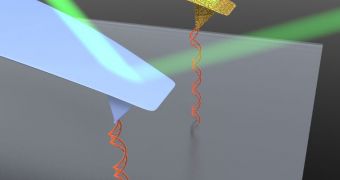Atomic Force Microscopes (AFMs) are extremely sensitive devices, capable of handling structures such as DNA strands and single atoms, and also built atom-level structures. This is done through a probe called a cantilever, which is coated in gold. A new study shows the metal may not be necessary.
According to investigators from JILA, a joint institute of the National Institute of Standards and Technology (NIST) and the University of Colorado Boulder (UCB), gold may not be needed as a coating for the tip of AFM probes.
Until the new study published its conclusions, the gold coating was widely considered to be a useful addition to the cantilevers. That may be the case for several areas of research still, but not for studies conducted in biophysics.
JILA scientists performed a series of measurements in a special liquid used in nearly all types of AFM-based biophysical studies, and discovered that the device measured forces at such small levels with far greater precision without the gold.
Studies on topics such as stretching DNA or unfolding proteins may soon get a boost from the new discoveries, if the several science groups around the world that operate AFM machines decide to make the switch.
Details of the study appear in a paper entitled “Routine and timely sub-piconewton force stability and precision for biological applications of atomic force microscopy,” which was published in the June 13 online issue of the esteemed scientific journal Nano Letters.
According to the JILA group, they obtained a 10-fold improvement in measurement accuracy by using the gold-free cantilever. The tweak may contribute to advancing the field of nanotechnology, too.
“What I find interesting about this experiment is it's so incredibly simple. It takes a minute to strip the gold off a commercial cantilever and you get a 10-fold improvement in force precision,” NIST/JILA physicist Thomas Perkins explains.
“Gold exhibits a sort of complex elastic property in high-precision measurements. When you bend gold, it creeps a little bit, like silly Putty. Further, the lore in the field is that gold can crack, it can age, and molecules can bind to it – all of which may change its mechanical properties,” he adds.
“This problem is even worse when you do biological experiments in liquid,” Perkins concludes.

 14 DAY TRIAL //
14 DAY TRIAL //